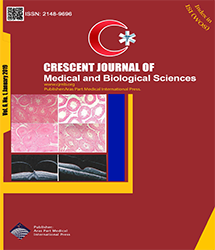
| Original Article | |
| Comparing the Effect of Flaxseed and Fish Oils on Acute Ischemia-Reperfusion Injury in the Rat Kidney | |
| Maryam Moghimian1, Seyed-Hosein Abtahi-Eivary2, Najme Jajarmy2, Mahdi Karimi Shahri3, Javad Adabi4, Majid Shokoohi5 | |
| 1Department of Physiology, School of Medicine, Gonabad University of Medical Sciences, Gonabad, Iran 2Department of Biochemistry, School of Medicine, Gonabad University of Medical Sciences, Gonabad, Iran 3Department of Pathology, School of Medicine, Gonabad University of Medical Sciences, Gonabad, Iran 4Clinical Laboratory, 22 Bahman Hospital, Gonabad University of Medical Sciences, Gonabad, Iran 5Department of Anatomical Sciences, Faculty of Medicine, Tabriz University of Medical Sciences, Tabriz, Iran |
|
|
CJMB 2019; 6: 006-012 Viewed : 7257 times Downloaded : 3200 times. Keywords : Renal ischemia-reperfusion, Oxidative stress, Fish oil, Flaxseed oil |
|
| Full Text(PDF) | Related Articles | |
| Abstract | |
Objectives: Polyunsaturated fatty acids (PUFAs) are useful in reducing the deleterious effects of ischemia-reperfusion (IR). This study was designed to compare the impacts of treatment with flaxseed oil (FLO), rich in linoleic and alpha-linolenic acids, and fish oil containing long PUFAs, as well as eicosapentaenoic and docosahexaenoic acids (DHAs), on IR injury in the rat kidney. Materials and Methods: In this experimental study, 32 male Wistar rats were randomly divided into 4 groups (8 rats each) including Sham, IR, FLO, and fish oil (FO). Correspondingly, experimental groups were administered saline and flaxseed or FO at doses of 0.4 g/kg by gavage. After 4 weeks, the rats underwent right nephrectomy and 45-minute clamping of the left renal arteries followed by 24 hours reperfusion. Renal function was assessed by measuring the serum creatinine (Cr) and blood urea nitrogen (BUN) levels. The oxidative stress and serum aspartate aminotransferase (AST) activity were measured. Each kidney was sectioned into 2 equal parts. One part was used for pathological evaluations after hematoxylin-eosin staining and the other one was applied in assaying the malondialdehyde (MDA) level. Results: Serum Cr and BUN levels, AST activity, and tissue MDA content increased in the IR group. Both FO and FLO decreased tissue MDA levels (P < 0.05 vs. IR), but could not lead to a significant reduction in the levels of the renal markers. In addition, histological damages which were increased following the IR were markedly reduced by these 2 oils. Conclusions: Generally, FLO and FO may provide protection against IR-induced renal injury and oxidative stress. However, these effects were not significant between the 2 supplementations. |
Cite By, Google Scholar
Google Scholar
PubMed
Online Submission System
 CJMB ENDNOTE ® Style
CJMB ENDNOTE ® Style
 Tutorials
Tutorials
 Publication Charge
Medical and Biological Research Center
About Journal
Publication Charge
Medical and Biological Research Center
About Journal
Aras Part Medical International Press Editor-in-Chief
Arash Khaki
Deputy Editor
Zafer Akan


















